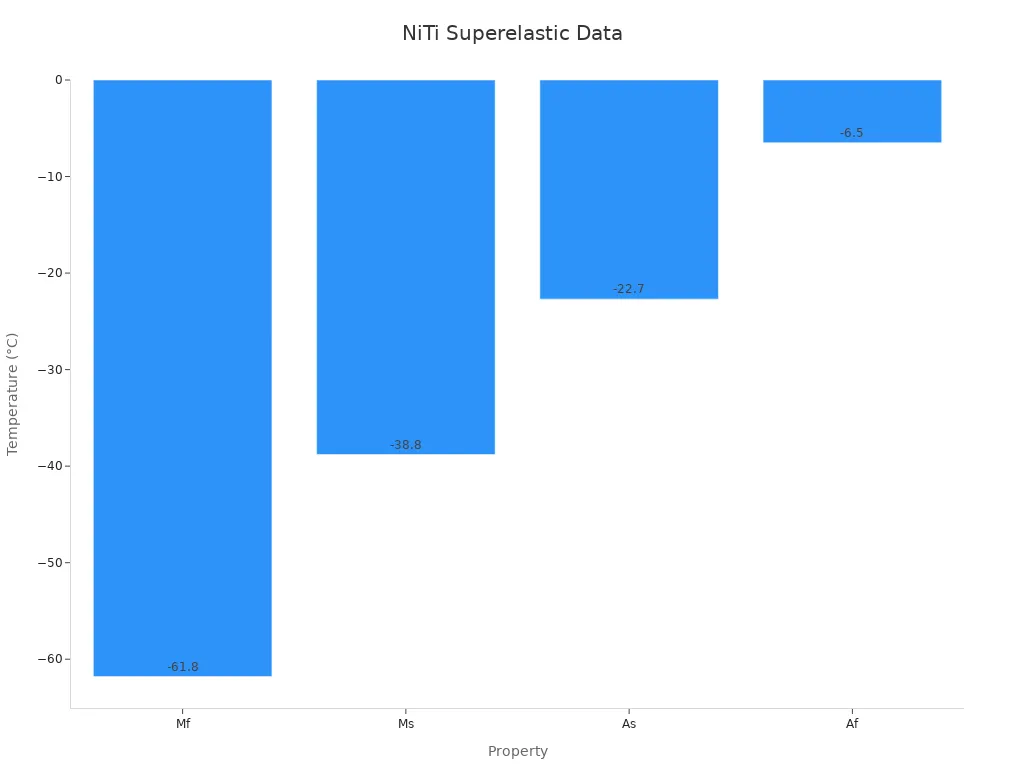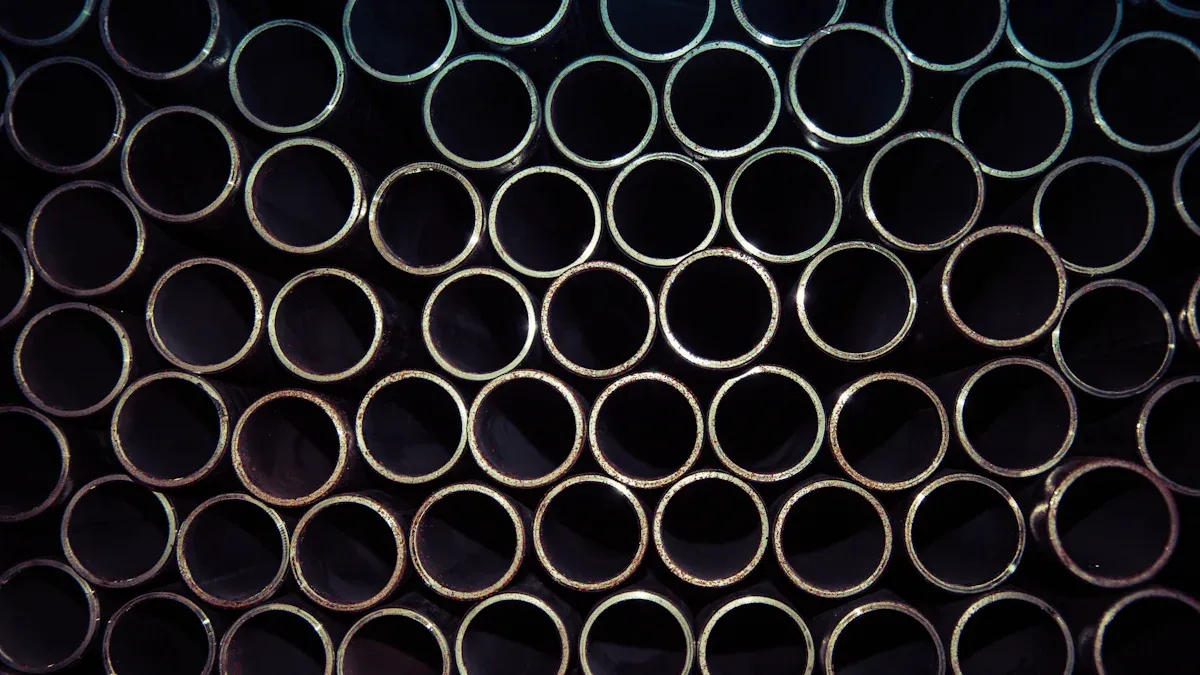Unveiling the Science of NiTi Superelasticity and Shape Memory Effects

NiTi, a nickel-titanium alloy, exhibits two remarkable properties: superelasticity and shape memory effects. These NiTi superelastic properties allow the material to recover its original shape after deformation, either through stress removal or temperature change. This unique behavior makes NiTi essential for advanced applications in technology and materials science.
In modern technology, the NiTi superelastic properties have been extensively studied. For instance, tensile tests with a sample size of n = 3 per condition confirm the reliability of its performance. Stress-biased thermal cycling tests and microstructural analyses further reveal how NiTi behaves under various conditions. These findings underscore NiTi's versatility and reliability as a material.
What enables NiTi to exhibit such extraordinary properties? Understanding its composition and behavior holds the key to unlocking its full potential in various industries.
Key Takeaways
NiTi is a mix of nickel and titanium. It can bend and return to its original shape.
It changes between two forms, austenite and martensite. This helps it bend a lot without breaking.
Heating NiTi improves it by changing its tiny parts. This also adjusts how it reacts to heat, making it better for tough jobs.
NiTi is used in many fields like medical tools, airplanes, and robots. It is strong, flexible, and safe for the body.
New ways to make NiTi, like 3D printing, are helping. These methods allow for custom parts and better results.
NiTi Superelastic Properties and Shape Memory Effects

Composition and Structure of NiTi
NiTi, also known as Nitinol, is a nickel-titanium alloy that exhibits unique mechanical properties. Its extraordinary behavior stems from its atomic structure and composition. NiTi typically contains nearly equal proportions of nickel and titanium, with slight variations influencing its performance. The alloy's crystal structure plays a pivotal role in its superelasticity and shape memory effects.
At high temperatures, NiTi exists in the austenite phase, characterized by a cubic B2 structure. This phase is stable and allows the material to return to its original shape after deformation. At lower temperatures, the alloy transitions to the martensite phase, which has a monoclinic B19' structure. This phase is more flexible and can accommodate significant deformation. An intermediate R-phase, with a hexagonal structure, sometimes appears during the transformation process. The specific structural parameters for these phases include:
Austenite (B2): a = 3.015 Å
Martensite (B19'): a = 2.898 Å, b = 4.108 Å, c = 4.646 Å, β = 97.78°
R-phase: a = 7.3451 Å, c = 5.2718 Å
The ability of NiTi to switch between these phases without long-range atomic diffusion is the foundation of its remarkable properties.
Austenite and Martensite Phase Transformations
The transformation between austenite and martensite in NiTi is a first-order structural transition. This process is thermally activated and occurs within specific temperature ranges. The transformation temperatures include:
Martensite Start (Ms): -38.8 °C
Martensite Finish (Mf): -61.8 °C
Austenite Start (As): -22.7 °C
Austenite Finish (Af): -6.5 °C

These temperatures determine whether the alloy exists in the austenite or martensite phase. Heat treatment can adjust these values, tailoring the material for specific applications. For example, heating NiTi at 850 °C for 30 minutes followed by rapid cooling enhances its performance by refining the phase transformation behavior.
The transformation process involves coordinated atomic shifts, allowing the material to change its structure without breaking atomic bonds. This mechanism enables NiTi to exhibit both superelasticity and shape memory effects, making it a versatile material for various industries.
Stress-Induced Martensite and Superelasticity
NiTi's superelastic properties arise from stress-induced martensite transformation. When stress is applied to the alloy in its austenite phase, it undergoes a reversible transformation to martensite. This process allows the material to absorb significant deformation and return to its original shape upon stress removal.
Quantitative measurements highlight the extraordinary nature of this behavior:
Measurement Type | Value/Observation |
|---|---|
Young's Modulus (Austenite) | ~70 GPa (average literature value), ~77.9 GPa (single crystal specimen) |
Maximum Strain | Up to 17% in polycrystalline specimens |
Stress Plateau Behavior | Increase in stress plateau with decreasing specimen thickness; stress drop observed at plateau onset |
The stress-induced transformation is accompanied by a characteristic stress-strain curve, featuring a plateau region where the material deforms at nearly constant stress. This unique behavior enables NiTi to withstand high strains without permanent deformation, making it ideal for applications requiring flexibility and durability.
Studies have shown that the microstructure of NiTi significantly influences its superelasticity. For instance, research on deformation localization and crack growth reveals how the alloy's structure affects its mechanical performance. Additionally, experiments on fatigue crack growth and fracture mechanics provide insights into the material's longevity under repeated loading.
NiTi's ability to undergo stress-induced martensite transformation and exhibit superelasticity sets it apart from other materials. These properties make it indispensable in fields such as biomedical engineering, aerospace, and robotics.
Thermal Activation and Shape Memory Behavior
NiTi alloys exhibit remarkable shape memory effects due to their ability to undergo thermally activated phase transformations. These transformations occur between the austenite and martensite phases, driven by temperature changes. The shape memory effect allows NiTi to recover its original shape after deformation, making it a unique material with versatile applications.
Thermal activation plays a crucial role in controlling the transformation behavior of NiTi. When the alloy is heated above its austenite finish temperature, it transitions from the martensite phase to the austenite phase. This process restores the material's original shape, even after significant deformation. Conversely, cooling the alloy below its martensite start temperature induces a transformation back to the martensite phase, enabling flexibility and adaptability.
Several factors influence the thermal activation and shape memory effect properties of NiTi. These include alloy composition, heat treatment, and temperature hysteresis. The table below highlights how these parameters affect the transformation behavior and overall performance of NiTi:
Parameter | Effect on Shape Memory Behavior |
|---|---|
Cu Alloying | Changes transformation from one-step to two-step, affecting phase stability |
Heat Treatment | Improves superelastic properties through grain refinement and texture control |
Temperature Hysteresis | Smaller hysteresis indicates less damage and improved fatigue performance |
Heat treatment is particularly significant in enhancing the deformation behavior of NiTi. By refining the grain structure and controlling the texture, heat treatment optimizes the alloy's superelasticity and shape memory effects. For instance, heating NiTi to specific temperatures and rapidly cooling it can improve its biocompatibility properties, making it suitable for biomedical applications.
Temperature hysteresis, another critical factor, measures the difference between the heating and cooling transformation temperatures. A smaller hysteresis indicates better energy efficiency and reduced material fatigue. This characteristic enhances the longevity of NiTi in applications requiring repeated thermal cycling.
The transformation behavior of NiTi under thermal activation is not only reversible but also highly reliable. This reliability stems from the material's ability to undergo phase changes without long-range atomic diffusion. As a result, NiTi demonstrates exceptional durability and performance in demanding environments.
Mechanical Behavior of NiTi
Deformation and Recovery Mechanisms
NiTi exhibits exceptional mechanical properties due to its unique deformation and recovery mechanisms. When subjected to stress, the alloy undergoes a phase transformation from austenite to martensite. This transformation allows the material to deform significantly without permanent damage. Upon stress removal, the reverse transformation restores the original shape, showcasing its superelastic behavior.
The recovery process in NiTi relies on its ability to switch between phases without atomic diffusion. This characteristic ensures that the material retains its structural integrity even after repeated deformation. The mechanical properties of NiTi, such as its high strain tolerance and stress plateau behavior, make it ideal for applications requiring flexibility and durability. These properties are particularly valuable in biomedical engineering, where materials must endure cyclic loading without failure.
Transformation Temperatures and Their Role
The phase transformation temperatures of NiTi play a critical role in determining its mechanical properties and performance. These temperatures, including the martensite start (Ms) and austenite finish (Af), dictate whether the alloy exists in the austenite or martensite phase. For example, the transformation temperatures for two NiTi alloys are as follows:
Alloy | Af (K) | Ms (K) |
|---|---|---|
NiTi_1 | 310 | 269 |
NiTi_2 | 292 | 282 |
Heat treatment significantly influences these temperatures by altering the alloy's microstructure. For Ni-rich NiTi alloys, short heat treatments at low temperatures promote the formation of Ni4Ti3 precipitates. These precipitates modify the phase transformation path, sometimes resulting in a two-step transformation. The thermal history and Ni–Ti ratio also affect the transformation temperatures, enabling engineers to tailor the alloy for specific applications.
Fatigue Resistance and Longevity
NiTi's fatigue resistance and longevity under cyclic loading make it a standout material in engineering. The alloy's ability to endure repeated stress cycles without significant degradation stems from its unique phase transformation mechanism. Studies on cyclic fatigue resistance reveal differences in performance based on loading conditions. For instance:
Fracture times for various NiTi instruments range from 1,626 seconds (Micro Blue) to 2,584 seconds (Only One File Blue).
Significant differences in fatigue resistance occur between speed groups, with faster speeds generally reducing longevity.
The mechanical properties of NiTi, such as its high strain tolerance and stress-induced phase transformation, contribute to its durability. These characteristics ensure reliable performance in demanding applications, including aerospace and robotics. By optimizing heat treatment and alloy composition, engineers can further enhance the fatigue resistance of NiTi, extending its lifespan in critical applications.
Applications of NiTi in Modern Industries

Biomedical Applications: Stents and Orthodontics
NiTi has revolutionized biomedical applications due to its superelasticity and shape memory effects. These properties make it an ideal material for stents, orthodontic wires, and other medical devices. Its ability to recover its original shape after deformation ensures reliability and precision in critical procedures.
Self-expanding stents made from NiTi demonstrate exceptional performance in minimally invasive surgeries. These stents utilize the alloy's superelastic property and mesh structure to adapt to patient-specific anatomies. The table below highlights the key features and advantages of NiTi-based stents:
Application | Key Features | Advantages |
|---|---|---|
Self-expanding stents | Superelastic property, mesh structure | Enables minimally invasive procedures, patient-specific solutions |
In orthodontics, NiTi wires provide consistent force over extended periods, reducing the need for frequent adjustments. This property enhances patient comfort and treatment efficiency. Additionally, NiTi's biocompatibility ensures safe and effective integration with the human body.
NiTi also plays a crucial role in load-bearing and non-load-bearing implants. Its stress-strain hysteresis, similar to bone, prevents stress shielding in hip implants. Porous NiTi objects, with precise geometrical accuracy, promote osteointegration and reduce stress shielding. The table below summarizes these applications:
Application | Key Properties | Benefits |
|---|---|---|
Load-bearing hip implants | Stress-strain hysteresis similar to bone | Prevents stress shielding, high recovery strain |
Non-load bearing implants | Excellent biomechanical compatibility | Contributes to success in biomedical applications |
Porous NiTi biomedical objects | Precise geometrical accuracy | Reduces stress shielding, promotes osteointegration |
AccuPath's Nitinol Tubing has become a trusted choice for biomedical applications. Its high-quality manufacturing ensures superior performance in stents, orthodontics, and implants, making it indispensable in modern medicine.
Aerospace and Robotics: Precision Engineering
NiTi's unique properties have made it a cornerstone in aerospace and robotics. Its ability to undergo significant deformation without permanent damage ensures reliability in engineering applications requiring precision and durability.
The alloy's high strength-to-weight ratio and vibration damping capabilities enhance structural resilience in aerospace components. NiTi's energy absorption and dissipation properties protect critical systems during extreme events. The table below outlines key performance metrics that support its use in precision engineering:
Metric | Value | Implication for Precision Engineering |
|---|---|---|
Shape Recovery Strain | 4.16% | Enables components to return to original shape after deformation |
Superelastic Strain | 7% | Allows for significant deformation without permanent damage |
Relative Material Density | 99.4% | Ensures high strength-to-weight ratio for aerospace applications |
Austenite Finish Temperature | 29 ± 5 °C to 72 ± 5 °C | Tailoring properties for specific operational environments |
In robotics, NiTi enables precise movement and variable stiffness mechanisms. Its versatility supports the development of compact actuation solutions, essential for soft robotics and surgical robots. These robots benefit from NiTi's ability to mimic biological movements and perform delicate manipulations.
NiTi's adaptability extends to fluid delivery systems and control surface actuators. These applications highlight its role in enhancing the efficiency and resilience of aerospace and robotic systems. AccuPath's Nitinol Tubing, with its exceptional quality, ensures optimal performance in these demanding fields.
Consumer Products and Emerging Technologies
NiTi's applications extend beyond specialized industries into everyday consumer products. Its superelasticity and shape memory effects have inspired innovations in eyewear, mobile devices, and wearable technology.
Eyeglass frames made from NiTi offer unmatched durability and flexibility. These frames can withstand significant bending and return to their original shape, providing long-lasting performance. In mobile devices, NiTi components enhance durability and functionality, ensuring reliability in compact designs.
Emerging technologies, such as smart textiles and adaptive materials, also leverage NiTi's properties. These innovations enable products that respond to environmental changes, offering enhanced user experiences. For example, NiTi-based actuators in wearable devices provide dynamic adjustments for improved comfort and performance.
AccuPath's Nitinol Tubing plays a pivotal role in these advancements. Its precision engineering and consistent quality make it a preferred choice for manufacturers seeking to integrate NiTi into consumer products and emerging technologies.
Challenges and Future of NiTi Shape Memory Alloys
Limitations in Extreme Environments
NiTi shape memory alloys face several challenges when used in extreme environments. Repeated cycling often leads to fatigue and degradation, reducing the lifespan of components. Temperature sensitivity limits their functionality to specific ranges, making them unsuitable for applications requiring stability under extreme heat or cold. High-stress conditions further exacerbate these issues. For instance, studies on Ni-rich actuator wires tested at 700 MPa reveal that while actuation remains feasible for millions of cycles, durability testing is both expensive and time-consuming due to slow cyclic test frequencies.
Manufacturing complexities also pose significant hurdles. Producing high-quality NiTi components involves costly and intricate processes. Alloy development often relies on trial-and-error methods, which consume time and resources. Additionally, strict regulatory requirements in industries like aerospace and biomedical engineering hinder the rapid adoption of new alloys. These limitations highlight the need for innovative solutions to enhance the performance and reliability of NiTi in demanding environments.
Advances in NiTi Alloy Processing
Recent advancements in NiTi alloy processing have addressed some of these challenges. Laser energy techniques now allow precise control over grain size and shape, improving both strength and flexibility. Higher laser energy produces smaller grains, which enhance the material's mechanical properties. Stress relief through heat treatment further ensures that NiTi retains its strength and flexibility after laser processing.
Efforts to optimize additive manufacturing processes have also shown promise. Understanding the relationship between process parameters has enabled engineers to tailor the functional and mechanical properties of NiTi components. Reports indicate that fatigue life has significantly improved, with some alloys achieving up to 600,000 cycles of consistent actuation. However, the lack of standardized guidelines for achieving high-density NiTi components remains a challenge. Continued research into additive manufacturing techniques could unlock new possibilities for customizing NiTi alloys for specific applications.
Expanding Applications Across Industries
The demand for NiTi shape memory alloys continues to grow across multiple sectors. In the medical field, the need for advanced devices has driven the adoption of NiTi for stents, orthodontic wires, and implants. The automotive industry has also embraced NiTi due to its lightweight properties, which contribute to fuel efficiency. Meanwhile, the aerospace sector seeks high-performance materials for aircraft manufacturing, where NiTi's durability and adaptability prove invaluable.
Emerging technologies like 3D printing have further expanded the potential applications of NiTi. Additive manufacturing enables the creation of customized components with complex geometries, opening new opportunities in robotics, consumer electronics, and beyond. As industries continue to explore the capabilities of NiTi, its role in shaping the future of engineering and technology becomes increasingly evident.
NiTi's superelasticity and shape memory effects stem from its unique phase transformation between austenite and martensite. These properties enable the alloy to recover its shape after deformation, making it indispensable in fields like medicine, aerospace, and robotics. Its ability to endure stress and adapt to temperature changes has revolutionized material science.
The growing demand for NiTi highlights its role in advancing technology. Innovations such as additive manufacturing and regional R&D investments are expanding its applications. The table below outlines key trends shaping NiTi's future:
Trend/Innovation | Description |
|---|---|
Medical Applications | NiTi rods are increasingly used in orthodontics and minimally invasive surgeries. |
Sustainability | Durable NiTi components align with eco-friendly practices. |
Technological Advancements | Additive manufacturing enhances performance and customization. |
Regional Developments | Asia-Pacific is emerging as a hub for NiTi production. |
Academic-Industry Collaboration | Partnerships foster innovation in new alloys and composites. |
NiTi's potential continues to grow as industries explore its capabilities. Its adaptability and durability promise to drive future innovations, shaping the next generation of engineering and technology.
FAQ
What makes NiTi alloys unique compared to other materials?
NiTi alloys stand out due to their superelasticity and shape memory effects. These properties allow them to recover their original shape after deformation. Unlike most materials, NiTi undergoes reversible phase transformations between austenite and martensite, enabling exceptional flexibility and durability.
How does heat treatment improve NiTi's performance?
Heat treatment refines NiTi's grain structure and adjusts its transformation temperatures. This process enhances superelasticity and shape memory effects. For example, heating NiTi at specific temperatures followed by rapid cooling optimizes its mechanical properties, making it suitable for demanding applications like biomedical devices and aerospace components.
Can NiTi alloys withstand extreme environments?
NiTi alloys perform well under many conditions but face challenges in extreme environments. High stress or temperature extremes can reduce their lifespan. Advances in alloy processing, such as laser energy techniques and additive manufacturing, aim to improve their durability and adaptability for harsher settings.
Why are NiTi alloys popular in biomedical applications?
NiTi's biocompatibility, flexibility, and shape memory effects make it ideal for medical devices. Stents, orthodontic wires, and implants benefit from its ability to adapt to the human body. Its stress-strain behavior also prevents issues like stress shielding, ensuring long-term reliability in medical procedures.
How does additive manufacturing benefit NiTi applications?
Additive manufacturing enables the creation of customized NiTi components with complex geometries. This technology improves design flexibility and reduces material waste. It also allows engineers to tailor NiTi's properties for specific uses, expanding its applications in robotics, aerospace, and consumer products.
See Also
Understanding Nitinol's Unique Properties: Shape Memory And Superelasticity
Nitinol Tubing: Innovative Uses In Modern Healthcare Equipment
Comprehensive Overview Of Nitinol Parts And Production Methods
Nitinol Tubing's Impact On The Evolution Of Medical Technology
Nitinol Tubes: Pioneering The Next Generation Of Medical Devices

